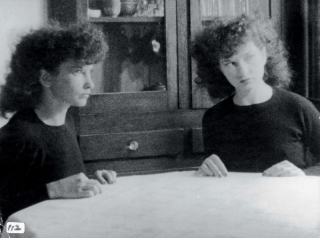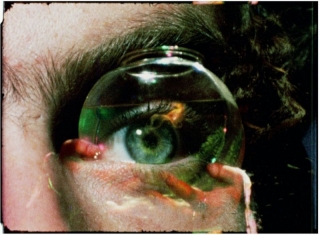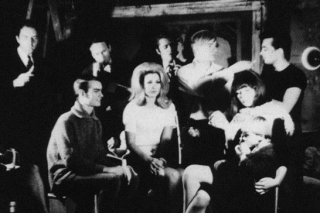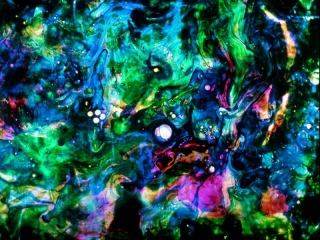Date: 15 October 1999 | Season: Leeds Film Festival 1999
AMERICAN UNDERGROUND PRIMER
Leeds International Film Festival
15 & 16 October 1999
The “American Underground Primer” is intended as a short introduction to the beauty and wonder of American experimental films. The wide-ranging “underground” classification covers many diverse styles including abstract, non-objective, structural, flicker, beat, poetic, personal, animated, diary and low budget films.
Avant-garde film production entered a golden age in 1943 with Maya Deren’s pioneering trance film Meshes Of The Afternoon, and this period of intense production ran through to the mid-1970s when structuralism became the predominant form. During this time numerous advances were made in the theories and techniques of personal filmmaking. These works have proved highly influential to feature film directors from Martin Scorsese through to Harmony Korine, and their inventiveness has informed the methods used in advertisements and pop videos.
With the explosion of “underground” film in the 1960s, the ability to make movies was extended to everyone and during this free thinking period many classics of the genre were made. It should be noted that though these little movies were produced with small or non-existent budgets they are still wildly innovative, entertaining and are eminently watchable by everyone, and should not be restricted to film buffs, students or weirdos.
The American Underground Primer programmes are curated by Mark Webber.
Back to top
Date: 15 October 1999 | Season: Leeds Film Festival 1999
AMERICAN UNDERGROUND PRIMER: 1
Friday 15 October 1999, at 6pm
Leeds Hyde Park Cinema
Maya Deren, Meshes of the Afternoon, 1943, 18 min
The making of Maya Deren’s first film was a key point in the advancement of the personal film. It is one of the earliest ‘trance’ films, a style which developed from the earlier European Surrealist films of the 1920s and 30s. Deren creates a subconscious world and portrays a dreamer disturbed by a series of irrational incidents.
Kenneth Anger, Invocation of My Demon Brother, 1969, 11 min
Kenneth Anger, one of the most well-known experimental filmmakers, fuses the magick of his mentor Aleister Crowley with the myths of Hollywood’s golden age. This film, which shows Anger performing the Equinox Of The Gods ritual and has a Moog synthesiser soundtrack by Mick Jagger, is one of his most intense productions.
Ken Jacobs, Little Stabs at Happiness, 1959-63, 15 min
Little Stabs at Happiness consists of several unedited camera poems which depict a wistful nostalgia for times passed. Two sections feature the legendary filmmaker and performer Jack Smith. Ken Jacobs went on to be an important influence on the Structural movement and since the 1970s has developed amazing 3D projection performances known as the Nervous System.
Paul Sharits, Piece Mandala/End War, 1966, 3 min
Paul Sharits produced a series of outstanding ‘flicker’ films in which rapid changes of colour result in perceptual hallucinations. Piece Mandala/End War is a concise and remarkable example of his stroboscopic style.
Shirley Clarke, Bridges Go Round, 1958, 8 min
Shots of immobile New York bridges are choreographically edited and printed in a way such that they appear to dance. The footage is repeated twice, once with a score by jazz arranger Teo Macero and again with a composition by electronic music pioneers Louis and Bebe Barron (best known for their soundtrack to The Forbidden Planet).
Bruce Baillie, Mass (for the Dakota Sioux), 1964, 24 min
A sombre examination of the American experience and a critique of modern society. Baillie masterfully combines footage from television, movies, film diaries and specially staged scenes to present a densely layered requiem dedicated to the Native American Indians.
Robert Breer, 69, 1968, 5 min
Robert Breer, whose films present continually evolving ideas in a witty, gentle style, is one of the most original and respected animators of the experimental movement. 69 is a kinetic investigation of geometric forms, building visual tension by rapidly alternating images.
Robert Nelson, Oh Dem Watermelons, 1965, 12 min
A classic underground romp starring the San Francisco Mime Troop and a dozen watermelons. The fruit is put through every possible use and treatment for comic effect and social comment. Minimalist composer Steve Reich arranged the soundtrack.
Back to top
Date: 16 October 1999 | Season: Leeds Film Festival 1999
AMERICAN UNDERGROUND PRIMER: 2
Saturday 16 October 1999, at 6pm
Leeds The Fruit Cupboard
Scott Bartlett, OffOn, 1968, 9 min
Scott Bartlett was one of the first filmmakers to utilise the newly developed video technology in his work. OffOn evolved in an audio-visual jam session and is a virtuoso display of image and sound processing.
Ian Hugo, Bells of Atlantis, 1952, 10 min
An impressionist cine-poem providing visual accompaniment to “The House of Incest”, which is read by its author Anais Nin. The magical fusion of image, text and sound vividly depicts the sunken city of the subconscious. Produced with technical assistance from Len Lye and an electronic soundtrack by the Barrons.
Jonas Mekas, Award Presentation to Andy Warhol, 1964, 12 min
Mekas, the irrepressible force behind the promotion and preservation of experimental film, is also known for his rapid-fire diary films. Award Presentation to Andy Warhol documents Mekas giving Warhol (and Factory superstars Gerard Malanga, Baby Jane Holzer and Ivy Nicholson) the Film Culture Sixth Independent Film Award. In contrast to his regular shooting style, Mekas, assisted here by Gregory Markopoulos, uses one long take to replicate Warhol’s own techniques.
Hy Hirsh, Autumn Spectrum, 1957, 6 min
The mysterious Hy Hirsh made a handful of freewheeling abstract compositions throughout the 1950s. This film contrasts sumptuous impressions of Amsterdam canals with a soundtrack by the Modern Jazz Quartet.
Owen Land (formerly known as George Landow), The Film that Rises to the Surface of Clarified Butter, 1968, 9 min
One of the forerunners of the structural movement, Land has made several witty and confusing films that question the materials and methods of filmmaking. The Film that Rises to the Surface of Clarified Butter depicts animated figures that have a life of their own but exist in the same space as their creator.
James Whitney, Lapis, 1963-66, 9 min
James Whitney, one of the pioneers of computer animation, presents a constantly evolving mandala image as a highly psychedelic meditation tool.
George Kuchar, Hold Me While I’m Naked, 1966, 15 min
The Kuchar Brothers’ films are no-budget homages to Hollywood, which depict their own mundane lives as glamorous Technicolor dramas. Hold Me While I’m Naked is a hilarious parody of the frustration and loneliness of a Bronx filmmaker who thinks everyone is having a more exciting, sexier time than he.
Larry Jordan, Duo Concertantes, 1964, 9 min
Larry Jordan became known for constructing exquisite animations from surreal Victorian engravings. This procedure generates radical juxtapositions of scale, spatial relationships and the associative qualities of objects. Rococo imagery mixes with space age symbols as a mystical lady with an orbital head moves through the carnival of life.
Tony & Beverly Conrad, Straight and Narrow, 1970, 10 min
After making The Flicker, which consists solely of alternating black and white frames, the composer Tony Conrad collaborated with his wife Beverly on Straight and Narrow. Accompanied by psychotic music from John Cale and Terry Riley, rapidly changing horizontal and vertical lines produce visual hallucinations of colour and complex patterns.
Back to top
Date: 17 October 1999 | Season: Leeds Film Festival 1999
STAN BRAKHAGE SPECIAL PROGRAMME
Leeds City Art Gallery
Sunday 17 October 1999, at 2pm
Five short films by Stan Brakhage will follow the screening of Jim Shedden’s documentary on the legendary filmmaker.
Stan Brakhage, Mothlight, USA, 1963, 4 min
Made without a camera, Mothlight was constructed by sandwiching moth wings, flowers and other organic matter between two strips of clear Mylar editing tape. This collage was then printed on 16mm film. The image, which rapidly flashes by, is regarded by the filmmaker to be “as a moth might see from birth to death if black were white”.
Stan Brakhage, Reflections on Black, USA, 1955, 12 min
The visions of a blind man depict an erotic and aesthetic quest, which transcends the distinction between fantasy and reality. This angst-ridden drama of relationships in a New York tenement building is an early example of Brakhage’s rejection of sound, which he believes interferes with the purity and clarity of vision.
Stan Brakhage, Night Music, USA, 1986, 30 sec
Stan Brakhage, Rage Net, USA, 1988, 30 sec
Stan Brakhage, Glaze of Cathexis, USA, 1990, 4 min
In recent decades, Brakhage has concentrated his efforts mainly on “moving visual thinking”, created by painting directly onto film, or physically scratching into the emulsion. Night Music was originally painted on IMAX but has unfortunately never been presented in that format. Rage Net and Glaze of Cathexis both trace psychological states through hypnotic rushes of colour and form.
Back to top



